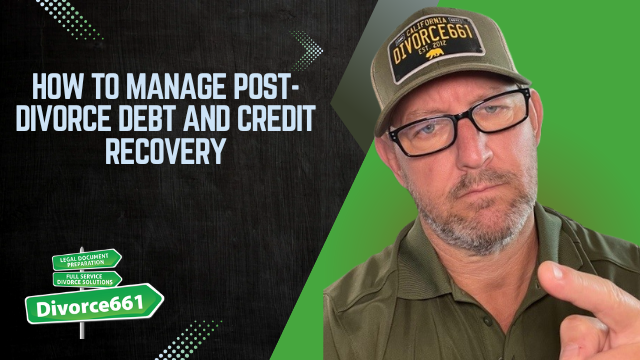How to Maintain Financial Independence After Divorce? | Los Angeles Divorce
I’m Tim Blankenship with Divorce661. If you’ve just gone through a divorce, one of the biggest concerns you’re likely facing is money — how to manage it, how to feel secure, and how to regain control of your financial life. In this article I outline practical steps you can take right now to build and maintain financial independence after divorce, with real-world tips I use with clients at Divorce661.
“One of the biggest concerns people face after divorce is how to maintain their financial independence.”
What to expect: the new financial reality
Divorce changes your household finances. Whether you were the primary breadwinner or relied on your spouse’s income, the first step is accepting the current reality and planning around it. That means creating a budget based on your post-divorce income and obligations — not the household budget from when you were married.
Create a realistic post-divorce budget
A working budget is the foundation of financial independence. Start with a clear picture of what you have coming in and what must go out each month.
Items to include in your budget
- Income: wages, self-employment income, child support, spousal support, investment income.
- Fixed expenses: mortgage or rent, utilities, insurance, loan payments, child care.
- Variable expenses: groceries, gas, medical costs, entertainment.
- Divorce-related obligations: any debts or monthly obligations allocated to you in the settlement.
- Savings: even small amounts — an emergency fund and retirement contributions matter.
Practical budgeting steps
- List every source of income and every expense for the month.
- Prioritize essentials (housing, food, utilities, insurance, debt minimums).
- Cut nonessential spending until you can comfortably cover essentials and save.
- Set a modest, achievable savings goal (even $25–$100/month) and increase it over time.
- Review and adjust your budget monthly during the transition period.
Build your own credit and financial identity
Financial independence means having accounts, credit, and a financial history in your name. If you relied on your ex for credit or bill-paying, rebuilding your financial identity is crucial.
Steps to rebuild and protect your credit
- Open accounts in your name: checking, savings, and a credit card or secured card if needed.
- Monitor your credit report: check for errors and for any lingering joint accounts. You can obtain free reports periodically and should review them regularly.
- Use credit responsibly: pay on time, keep balances low, and avoid opening too many accounts at once.
- Consider secured credit cards or small installment loans: these can help re-establish a positive payment history if your credit is limited.
Close or convert joint accounts to avoid future liability
Joint accounts left open after a divorce can create financial risk. Make sure you aren’t unknowingly liable for a shared credit card or bank account your ex still uses.
Joint account checklist
- Identify all joint accounts — bank accounts, credit cards, loans, utilities, subscriptions.
- Close joint credit cards or remove authorized users; get written confirmation.
- Convert shared bank accounts to individual accounts or close them and transfer funds.
- Notify creditors and service providers of account changes.
- If an account can’t be closed immediately, arrange written agreements or monitoring until it can be resolved.
Automate, organize, and gain confidence
Organization reduces stress and prevents missed payments. Automation and simple systems turn an overwhelming task into manageable steps.
- Set up automatic payments for recurring bills to avoid late fees and protect your credit score.
- Create a bill calendar or use budgeting software to see due dates and cash flow.
- Keep a folder (digital or paper) with important documents: divorce decree, settlement details, insurance policies, account closing confirmations, tax documents.
Real client story: from overwhelmed to empowered
I worked with a client who had never handled household finances before her divorce. She was terrified to take over. Together we organized her bills, set up automatic payments, and created a clear budget that matched her new income. Within months she went from overwhelmed to empowered — and was even able to start saving toward her first solo vacation after the divorce. Small, consistent steps make big differences.
Resources and professional help
At Divorce661 we offer tools and referrals to help you through the financial transition. Our support includes:
- Post-divorce financial planning tools
- Budgeting checklists and templates
- Referrals to trusted tax, credit, and retirement professionals
- Flat-fee pricing and 100% remote service to simplify the process
Small steps you can take today
- Create a simple budget listing income and monthly obligations.
- Open a checking or savings account in your name if you don’t already have one.
- Check your credit reports and dispute any incorrect accounts.
- Close or convert joint accounts and get written confirmations.
- Set up one automated payment (rent/mortgage or a key utility) to reduce stress.
Conclusion — take control and move forward
Maintaining financial independence after divorce is absolutely possible. Start with a realistic budget, build your own credit and financial identity, close joint accounts, automate what you can, and ask for help when needed. If you’re adjusting to life after divorce and want help building a financially independent future, visit divorce661.com to schedule a free consultation. We’ll help you take control of your finances, set realistic goals, and move forward with clarity and confidence.










